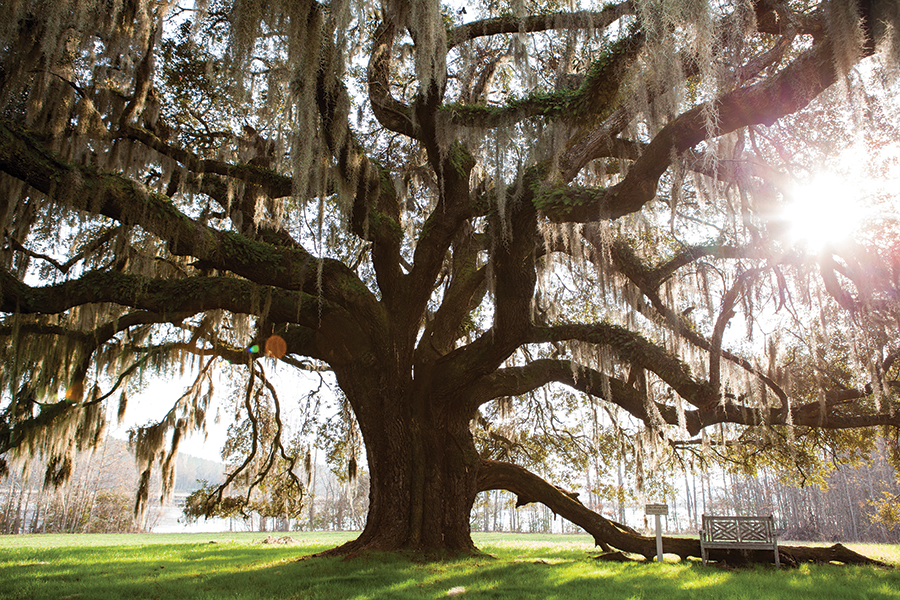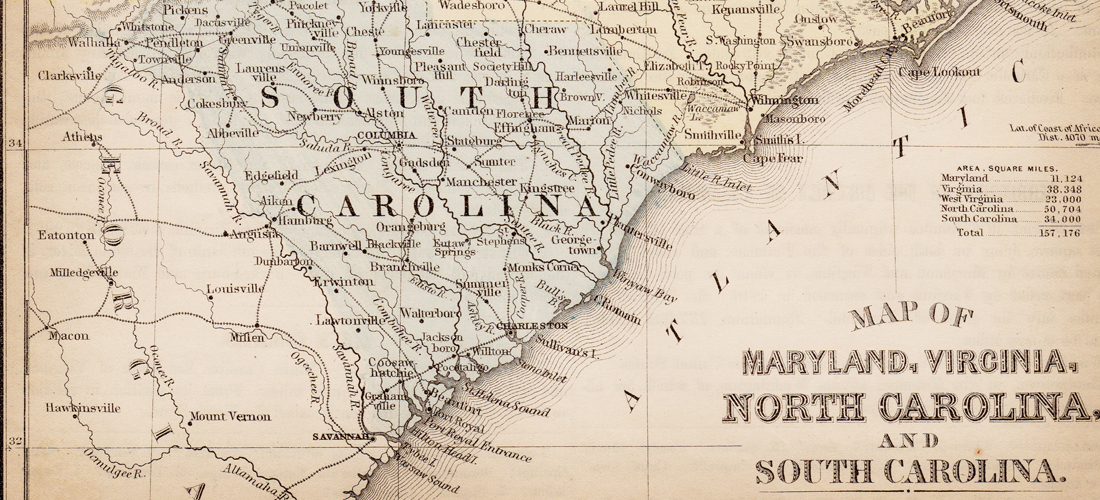Live Oak Love Affair
An arboreal ode to the monarch of the Southern forest
By Nan Graham • Photograph by Andrew Sherman
The Druids, those weird ancient Brits, viewed the oak tree as a spiritual entity, an object of worship. It was the chief among oaks, among all trees. They considered the oak to be a “cosmic storehouse of wisdom,” king of the forest. The personification of strength and wisdom. Unbeatable.
Among the legends of the tree is its relationship with mistletoe, which grows at the peak of the tree. With its inherent femininity, it literally hangs out with the masculine oak. The oak topped with mistletoe are the woodland “power couple.” The combination assures a happy marriage, so believers say.
Another clinging sweetie is the resurrection fern, which appears to wither and die on the oak’s branch but magically springs back to life when it gets a good rain. The live oak not only hangs out with mistletoe and resurrection fern, but is also partial to Spanish moss as well here in the Cape Fear Low Country. The long, gray beards of the Spanish moss have become a signature characteristic of this Southern icon. Thankfully, none of these cuddling attachments are parasites, and they do add to the seductive mystery of the live oaks.
The Roman author Pliny tells of eating acorns as a way of divining the future. But mystical qualities are not the live oaks’ only attributes. Medical uses of its acorns and bark also appear in North America and Europe. Native Americans used acorns and bark remedies to heal bleeding, swelling and even eradicate tumors. In Europe, the oak was used as an antidote for poisons, a diuretic for swollen ankles, and a quinine substitute for fevers by herbalists. The Welsh rubbing an oak tree “with the palm of the left hand on Midsummer’s Day” assures every day in the coming year will be a healthy one.

The following curative instructions were given for various illnesses: Walk around the oak. Concentrate on your ailment going away. Wish for the problem to be carried away by the first bird to light on the tree after you complete the directions. There . . . you are cured.
Here in the Cape Fear Low Country, the live oak, signature tree of the Deep South, is bountiful. The Southern oak reaches old age at 700 and approaches the end of its life at 1,000 years. Though the Great Basin bristlecone pine takes the prize as the oldest tree in the world — 5,067 years old, outliving even the sequoias on our West Coast — the Southern live oak may be the most beloved of the giant trees.
The Southern live oak, or Quercus virginiana, even has her own society: 8,680 members strong! Not a single member of the Live Oak Society is a human being; except for the person who serves as chairman, all the members are live oaks. All officers of the society are trees. Founded in 1934, the society has only had two presidents. The first, Locke Breaux, lost her life in 1968; she succumbed to ravages of water and air pollution. The president today, Seven Sisters Oak (since 1968), with her 38-foot waistline, is thought to be 1,200 years old. Other society officers boasts four vice presidents whose names and waistlines are: First Vice President: Middleton Oak ( 31feet) ; 2nd Vice President: St. John Cathedral Oak ( 27 feet); 3rd Vice President: Lagarde ( 29 feet), and 4th Vice President: Martha Washington Oak, who measures in at 28 feet.
Four of the five tree officers are from Louisiana — Louisiana has the most registered members, but Mississippi, North and South Carolina as well as Alabama and Georgia have all made sure their oak debutantes have made the society. The one human part of the Live Oak Society is Mrs. Coleen Landry of Louisiana. Membership rules are stringent. Like an applicant for a Miss America pageant, the oak must have certain waist and height measurements. To be admitted to the society, experts determine that an oak applicant must have a minimum girth (circumference of trunk) of 8 feet. An astounding 96-inch waist! What we would call, back in the day, “a stout gal.” Younger tree members, known as the Junior Leaguers, have a girth of 8 to 16 feet. The Centenarians must measure a waist exceeding 16 feet. (Do they call these sustainers?)
Wilmington’s Airlie Oak dates back to around 1545, according to Janine Powell of Airlie Gardens, and she (the oak, not Janine) is not a member of the Live Oak Society based in Louisiana. She is approximately 460 years old with a 21-plus-foot waist when last officially measured by the N.C Forest Service.
The Airlie Oak does hold a title, however. She is the North Carolina state champion live oak. Her competition for the crown is unknown, but she stands serenely on the banks of Bradley Creek in Wilmington, surrounded by her younger sister oaks.
Stories hold that Pembroke Jones is said to have been the Jones of the “Keeping up with the Joneses” cliche. He held elegant dinner parties up in the mossy branches of the ancient live oaks. No photographs exist of these tree dinners, where dinner guests were served seated on platforms in the live oaks overlooking the creek. But a few years ago, an anonymous benefactor sent several handsome guest books from Airlie with signatures and comments of its visitors. Written snippets mention the treetop dinners served on tables on platforms nestled in the branches of the leafy giants and confirm the legend as fact!
Pembroke Jones’ guest book is now with the Cape Fear Museum, where familiar names from the Wilmington past are interspersed with pencil-and-ink drawings by the guests: A mega fish covers two pages of the oversize book. On another page, a battleship is carefully sketched next to a 1918 entry, in which a guest writes about its predicted prowess if it goes to battle in World War I. The collection includes lots of loose photographs of unknown guests meandering through the gardens or chatting on the banks of Bradley Creek, laughing at some lost joke on the steps of the porch. (Note to readers: Always record the “who, when and where” on the back of all of your photographs. Otherwise, in years to come, the ghostly, unidentified images from the past will remain just that . . . ghosts.)
A few weeks ago, with historian Chris Fonvielle as our intrepid leader, our Salt senior editor Bill Irvine, writer John Wolfe and I struck out on a field trip through Old Town Plantation to look for local oak specimens. We drove past a tackle (as they call these tar kilns) indention in the ground, which Chris explained to us was an abandoned homemade pit. The pit was lined with clay where pine trees are burned to capture their resin to make tar. Tar is an essential for naval stores to waterproof wooden ships.
As our group ventured farther in, the live oak presence became the predominant forest. Some giants were out in the open, sentinel trees they are called because travelers use them to find directions. We circled the first mega-oak, which had been in front of a long-lost house in some previous lifetime. Now it stands on the edge of an exhausted and withered cornfield, empty of the feed used for the hunting fields. The tree is majestic and we measured it as about “17 feet circumference and change,” as John said. A mere teenager when compared to the dames in the Live Oak Society, whose president’s waist was better than twice our gal’s.
But this tree was endowed enough to be a “Junior Leaguer” member. Her 17 feet proved her eligibility according to Live Oak Society’s standards, and we were proud. Her spreading branches were gnarled and impressive; she seemed to preen over her bare open space. We even found shards of pottery and china nearby in the dirt road, which must have been from the long-gone house some distance back. Chris found a fragment of black glass bottle, a bottle that may have been opened to pour a glass of port or homemade wine to celebrate a New Year in 18th-century Colonial Carolina.
Down the road was another towering oak with a surprise beneath her branches: a giant circle of recumbent and sitting dog statues surrounding the outer branches of the tree. Through the years, the property owners had had a succession of Labrador retrievers and this was their final resting place, marked with these stone images. Serene under their magnificent oak, they seem to patiently wait for the return of their owner.
At last we came to a secluded grove of live oaks that was as hushed and beautiful as any sanctuary. No sentinel oak here. The oaks gathered as a mute congregation, dappling the ground beneath them. It was a fitting end to our excursion as we stood in the silence of these giants.
Jim Batey has a sprawling live oak farm right here on Aspen Road in Castle Hayne. He showed me the spread, which is home to more than 3,000 live oaks of varying ages for customers to choose from. You can wander among the young trees to decide which one speaks to you and — trust me — one will call your name. Some are in the ground and have to be spaded to move to your location; others come in a tublike mesh container, to be lifted onto a truck for transport, delivery and installation.
I met all the tree farm critters too: a mouser who appeared and stayed, a rescue dog of undetermined ancestry named Charlie and his most unlikely farmhand — an enormous pig named Melvin for the BBQ restaurant in Charleston. Melvin has an incredible back story . . . Charles Dickens would have wept with envy.
After hurricanes Fran and Floyd, Jim was helping out a friend on a flooded hog farm near Savannah. Down one of the trenches floated a huge corpse of a hog, victim of the flood. But clinging to his mother was a tiny piglet no bigger than a teacup. Today Melvin lives the good life in his pen on the live oak farm after that traumatic rescue. He is a friendly, happy 400-pound soul, showing no signs of PTSD from his harrowing beginning. Some pig!
Jim has the largest operation of the kind in this part of the South. He says when the city buys his trees, they always select those with slim, straight trunks for planting on city streets. Reason for their shape: no sprawling branches inviting children or overserved partygoers easy access to a climb.
Jim’s colorful past includes owning and restoring a lighthouse called Bloody Point by the Native Americans; owning and operating a boat that ferried passengers from the mainland near Beaufort, S.C. (that’s BEW-fort down there, not like our BO-fort in North Carolina), to Dafuskie Island of Pat Conroy fame. Read the Water Is Wide by Pat, a riveting tale of Conroy’s first and last job teaching school on the isolated and primitive island. Jim Batey — as the mailman, ferryman, grocery deliverer — knew Conroy. So being Southerners, we were compelled to swap Conroy stories before returning to the live oak agenda.
Many oaks are celebrities on their home turf. The Angel Oak with those ground-hugging branches is a tourist attraction there in South Carolina. Here we have the Airlie Oak, and a favorite of mine, the big oak at Jackson’s Big Oak BBQ, is a stand-out. Even my street has a giant unnamed oak, near its entrance in the yard of an antebellum house overlooking the Intracoastal Waterway. Like the vanished Airlie Dinner platforms, this oak has a platform in its ancient arms, benches there, and a wrought-iron spiral staircase to climb. Festooned with Spanish moss, it seems almost a prop to our Low Country with its view overlooking the waterway.
And who knew that Walt Whitman ventured south and stayed long enough to write a sheath of poems to our Southern part of the world? And to the live oak in particular . . . And it is so reflective of his view of the world.
I saw in Louisiana a live-oak growing,
All alone stood it and the moss hung down from the branches,
Without any companion it grew there uttering joyous leaves of dark green,
And its look, rude, unbending, lusty, made me think of myself . . .
Ah, Walt . . . so predictably self-absorbed. Even the enormous Quercus virginiana stands in the shadow of the poet. But that unruly ego aside, the poem is a shout-out for the magnificent Southern live oak…that moss-draped giant of a tree. And she is ours, the most iconic object of our arboreal obsession. b
Nan Graham is a regular Salt contributor and has been a local NPR commentator since 1995.


